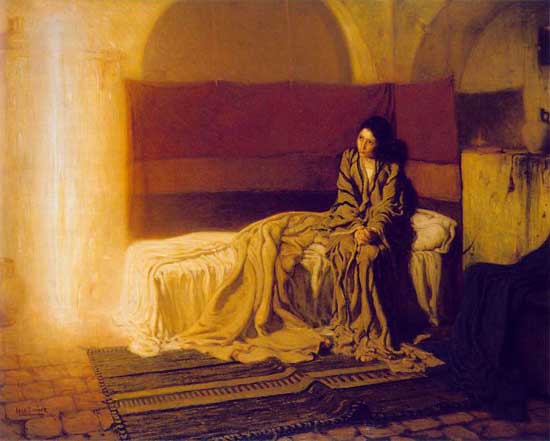In the sixth month of Elizabeth’s pregnancy, God sent the angel Gabriel to Nazareth, a village in Galilee, to a virgin named Mary. She was engaged to be married to a man named Joseph…
“Don’t be frightened, Mary,” the angel told her, “for God has decided to bless you! You will become pregnant and have a son, and you are to name him Jesus. He will be very great and will be called the Son of the Most High.” …
Mary asked the angel, “But how can I have a baby? I am a virgin.”
The angel replied, “The Holy Spirit will come upon you, and the power of the Most High will overshadow you. So the baby born to you will be holy, and will be called the Son of God.” …
Mary responded, “I am the Lord’s servant, and I am willing to accept whatever he wants. May everything you have said come true.” And then the angel left. — Luke 1:26-38, NLT
In the second supernatural encounter of the Christmas story, God became an embryo in the uterus of a remarkable young woman.
The Renaissance depictions of Mary’s encounter with Gabriel dress up the event like some 50’s Hollywood musical, with lush costumes and rich surroundings. It wasn’t like that, of course.
Henry Ossawa Tanner’s interpretation focuses on Mary’s vulnerability. Her room is spare. Her posture suggests humility, yet she looks up at the light and focuses her gaze on this angelic presence without fear. This Mary is an ordinary peasant with an unusual strength of mind and heart. One imagines that as she hears the angel’s words she is already ahead of him, working through the implications of this thing God is asking her to do.
“I am the Lord’s servant,” she says. The Greek is more literally I am the Lord’s slave. But Mary isn’t suggesting that she has no choice, for she continues: “May this thing happen as you have said.” She assents willingly. Mary sees herself voluntarily yoked to the will of God, and in that relationship she finds wholeness.
Theologians have labored to understand what this passage reveals about the nature and character of God. The difficulty is not that a virgin conceived. We focus on that hurdle primarily because we, ourselves, have become enslaved to a materialistic world view, where miracles are impossible.
But scientific rationalism cannot deny the possibility of miracles, or of a God who orchestrates them, because materialism is itself trapped in the material, and has nothing rational to say about the possibility of the immaterial — except, “We don’t know.”
The difficulty with the Christmas story isn’t the virgin birth. The difficulty is that the eternal, omnipotent Lord of heaven and earth — the Almighty God — became a zygote.
This child, this “Son of God” would be fully divine — conceived by some miraculous action of the Holy Spirit — yet fully human — genetically related to Mary through an egg that burst from her fallopian tubes, implanted itself into the wall of her uterus and began dividing in all of the usual ways.
Some have protested that for God to become human impossibly diminishes God. Others have argued that for the timeless and eternal Divine to bind itself to time and death is a logical impossibility. Even today, the Jehovah’s Witnesses and Islam, among other faiths, deny the deity of Christ.
The question “who was Jesus Christ” so consumed the early Christian church that Emperor Constantine called together the famous council at Nicaea in 325 A.D. to debate the issue. After much argument, the 318 bishops overwhelmingly agreed on an extra-biblical statement of faith that has since become known as the Nicene Creed.
We believe in one God, the Father almighty, … And in one Lord Jesus Christ, the Son of God, … of one substance with the Father, through Whom all things came into being, things in heaven and things on earth, Who because of us humans and because of our salvation came down and became incarnate, becoming human… — The Story of Christian Theology, Roger Olson
God the Creator himself had a mind-boggling encounter at Christmas. He learned human life, human nature, human limitation and frailty not via divine empathy, but by absorbing it all at the cellular level. He who created molecular biology became protein and amino acids, blood and water, flesh and bone.
The young virgin encountered an angel. Within hours, Mary had rushed off to her cousin Elizabeth’s house, perhaps to see if she was losing her mind, or to find some answers. Mary’s encounter with the Lord has become part of the centerpiece of the Christian story.
But what is more astounding is the encounter the Holy God had with humanity. The Christian story claims that God drew his blazing glory into a tiny point of light and became one of us, warts and all, out of love.
Illustration credit: Henry Ossawa Tanner’s Annunciation.



I’m really enjoying your insights Charlie. God became a zygote. That has all kinds of ramifications.